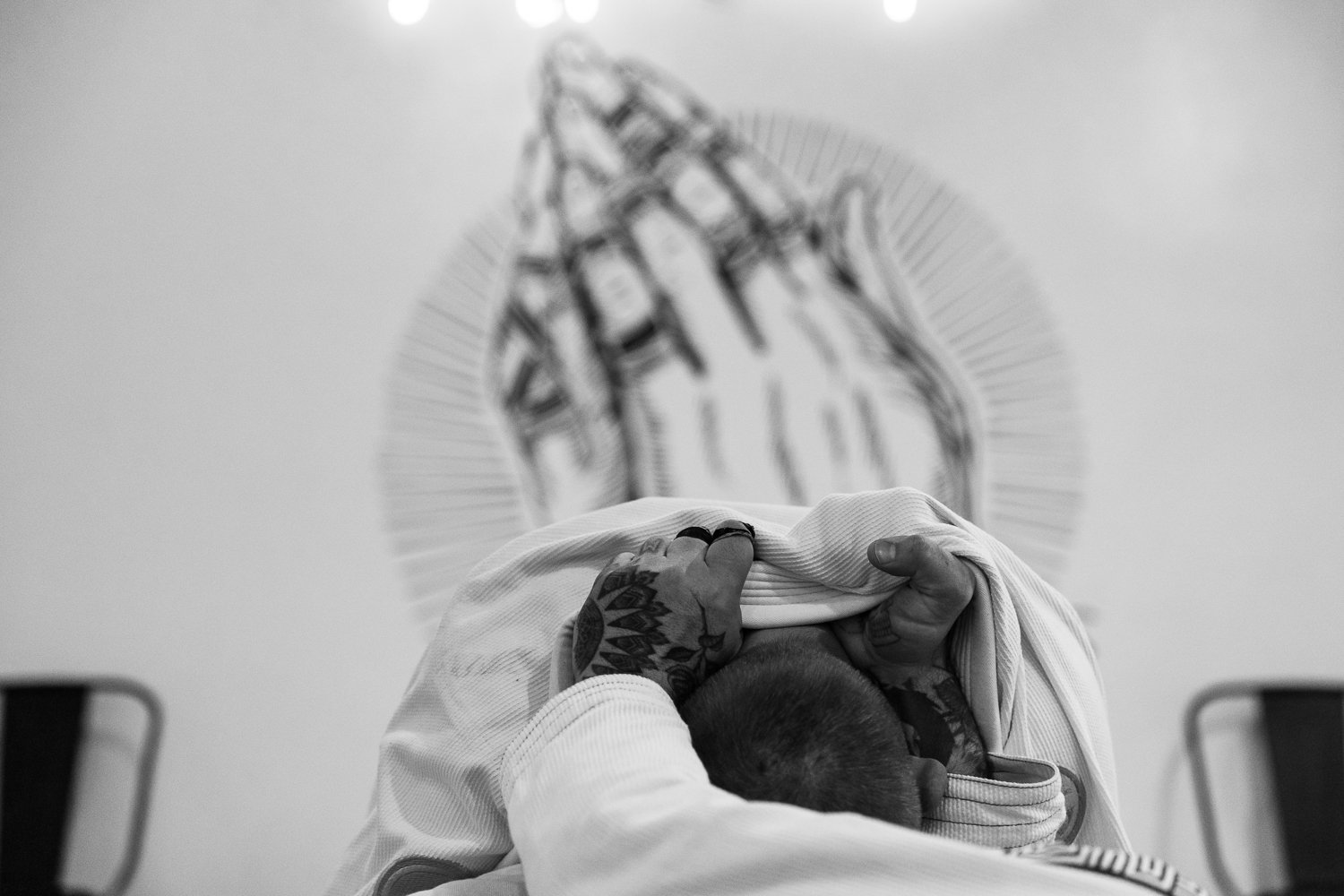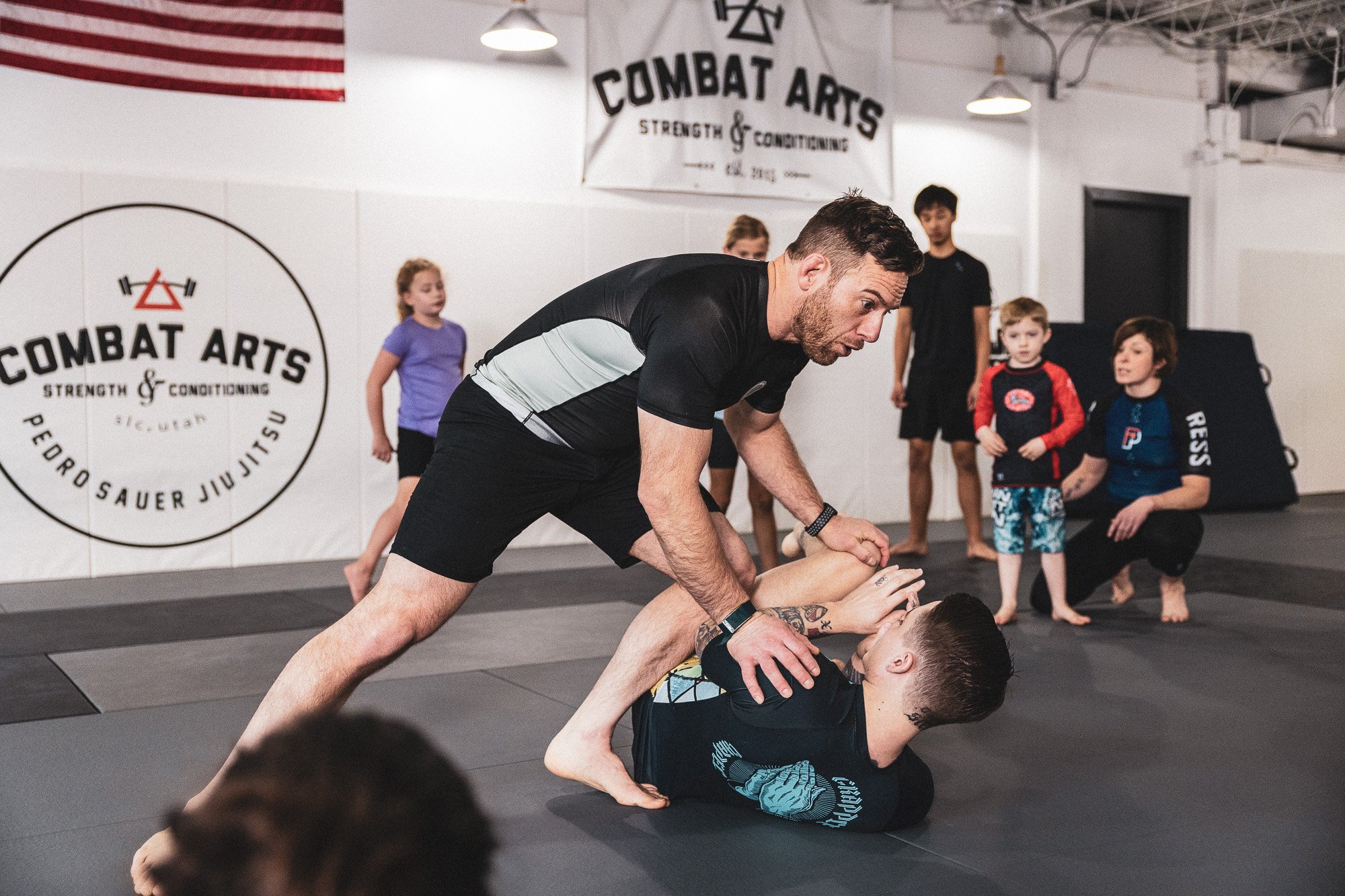adult Jiu-Jitsu.
Combat Arts welcomes everyone, regardless of what level they’re starting at. Here, it’s all about the individual’s journey, so you only have to live up to your own standards. Get ready to have fun, get in shape and learn Jiu-Jitsu on your own terms.
We offer a free week trial if you’d like to try it out before fully committing.
-
All classes begin on time, with a warmup routine followed by the day’s instruction and drilling, with the last half of class sparring.
-
Classes are Mon-Thurs (see schedule), and open mats on Friday and Saturday. No classes on Sunday.
-
Our goal is to keep pricing simple, with one rate for unlimited class access. We do have a few other options, see the link below to learn more and sign up.

Gi Jiu-Jitsu.
This class focuses on the Gi (uniform) aspects of Brazilian Jiu-Jitsu. Gi training is the root of Jiu-Jitsu and by training in the Gi you will develop a deep understanding of the Art. We firmly believe that Gi and NoGi (without the uniform) training are essential to knowing and using the concepts of Jiu-Jitsu. Each style has pros and cons and done together students simply improve at a faster rate. This is an all levels class in which we welcome new students to participate. We have uniforms you can borrow, some for sale or you can bring your own Gi. Any color is fine, as well as patches from other schools. We have no special rules for the class, just be clean, respectful and friendly while training.
No-Gi Jiu-Jitsu.
NoGi Brazilian Jiu-Jitsu is Jiu-Jitsu done without the Gi (uniform). The focus is on controlling someone without making Gi grips by using pressure, leverage and other concepts that can be found in wrestling and other grappling Arts. We believe it is important to train with and without the Gi to form a more complete knowledge of Jiu-Jitsu. These classes are open to all levels and we welcome beginners. Please wear work out clothes to this class or a rash guard and grappling shorts. There are no special rules for this class just be clean, respectful and friendly while training.
Belt Progression.
We follow the IBJJF belt progression guidelines. Everyone begins as a white belt and promotions are based on both overall time training as well as assessment of skill by your professor. For someone who trains consistently, it takes roughly ten years to become a black belt.
FAQs
What Is Brazilian Jiu-Jitsu?
With so many different martial arts styles out there, it's understandable why you might be wondering what Brazilian Jiu-Jitsu is and what makes it unique. Brazilian Jiu-Jitsu (BJJ) is a form of martial arts that focuses on grappling with the intent to submit your opponent. Submission is often achieved through joint locks and chokeholds. By understanding the principles of leverage and the inner workings and limits of the human body, a smaller, weaker opponent can overcome a larger, stronger opponent.
What Age Should I Start Training?
You can start learning Brazilian Jiu-Jitsu at almost any age. Whether you're a mature adult, a teenager, or a small child, it's never too late to start training. As to how early you can start, there isn't really a set age at which it becomes advisable. Jiu-Jitsu academies may set their own standards for how old a child must be to begin training, which is often around the ages of 4-6. Children must be mature enough to listen, communicate, and follow directions before they start training.
Is jiu-jitsu Fun?
Brazilian Jiu-Jitsu can be a lot of fun for those who practice it. Even children can enjoy it! The techniques are taught in a disciplined manner, but that doesn't mean it's not fun. Sparring sessions, warm-ups, and technique drills can help improve motor skills, and it's always fun to see yourself improve. BJJ dojos with experience in teaching children may make those drills game-based, increasing the level of fun that students experience.
Is Jiu-Jitsu Safe?
Given that BJJ emphasizes chokes and joint locks, it's only natural to be concerned about safety. As with all physical activities, there is an inherent risk of injury. However, any competent BJJ instructor will closely watch over their students to make sure they are respecting one another and practicing safely. Because strikes (punches and kicks) are not used in BJJ, it's actually a pretty safe martial art to learn. You don't see head injuries often, either. During class, steps are taken to prevent injury, such as practicing on padded mats. If you participate in Jiu-Jitsu, you can expect to experience some bumps and bruises, but serious injuries are uncommon.
Is Jiu-jitsu Good for Self-Defense?
BJJ can be an effective method of self-defense. Its focus on grappling and using both leverage and the ground increases the chances of someone small holding out and winning against a large opponent. Most fights end up on the ground, so it makes sense to train and prepare for that scenario. Controlling the fight on the ground reduces your risk of becoming injured and makes it more difficult for someone to strike you. You can gain an advantageous position on the ground, tire out your attacker, and force them to submit with a submission hold, a chokehold, or a joint lock. As with anything you intend to use as self-defense, it's important to practice it so much that it becomes instinctual and that you don't need to waste time thinking about what to do next when under the stress of a fight.
Is Jiu-Jitsu Good Exercise?
This form of martial arts can be a full-body workout. As you grapple or practice drills, you'll find yourself doing push-ups, squats, lunges, and more without even thinking about it. During BJJ classes, you can expect to be moving for the majority of the time. You'll be learning new techniques, practicing them, and grappling with opponents. Every step of the way, you're increasing your physical capabilities and pushing your body to new heights. Don't be surprised if you become more flexible and stronger at the same time. In addition to being a good cardio workout, you're strengthening your muscles and moving them through their range of motion. All of this to say that BJJ is great exercise!
What Should I Wear to My First Jiu-Jitsu Class?
Once you've decided to take a Jiu-Jitsu class, it's important to make sure you're properly outfitted. The right clothes help keep you and others safe. Rashguards (upper body) and spats (lower body) are generally worn under a gi to avoid burns and rashes. They also help you keep your body hair and sweat off the mat and your grappling partners. Get a gi with a belt (white, if you're just starting out) to make it easier to practice without worrying about your clothes getting in the way. Mouthguards and headgear or ear protection can provide additional protection against accidental injury. Don't wear glasses or jewelry, and make sure everything you're wearing to class is clean when you arrive. If you have long hair, consider styling it in a ponytail, braid, or bun to keep it out of the way.
What People Are Saying
“John is very knowledgeable and incredibly patient. The environment here is welcoming. I genuinely enjoy going and training jiu-jitsu. Our whole family goes to Combat. I would recommend learning from John to anyone.”
— Jade McCoy
“Having moved here from out of state, I was concerned about being able to find a gym and jiu-jitsu school that I would be comfortable at. After being recommended by a friend, I have now been training here for almost a year and it has become like a second home to me. The positive, challenging environment that John has created, has me counting down the time until I get to train every day.”
— Brandon Le Roy






